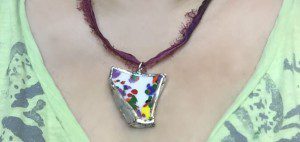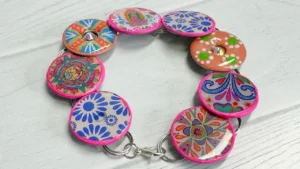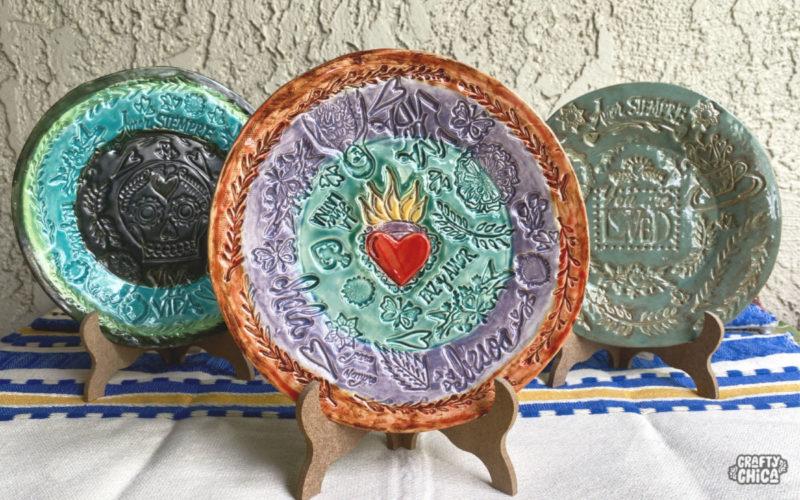Day of the Dead is a Mexican tradition combining Aztec and Roman Catholic practices and beliefs that date back many centuries. It is believed that on Nov. 1 and 2 the souls of our loved ones who have passed away are able to return to their homes and visit with friends and family.
Relatives prepare for their arrival with joy and respect. One way is to build a beautiful ofrenda (altar) in honor of the departed.
This festive skull banner will add a happy touch to your ofrenda.
Felt Skull Banner
Supplies
4 sheets of felt, 2 black and 2 white, each measuring 9 by 12 inches
Assorted sheets of other colors of felt
Skull template (see below)
Scissors
White craft glue or hot-glue gun
1 strand of thin ribbon, 24″ long
Optional: Embroidery thread and needle, sequins, felt flowers, fringe, buttons
Directions
Cut each sheet of felt into four pieces. Pull out eight pieces in assorted colors to use as your background and set aside. Take eight white pieces and, one by one, lay the template on top and cut around it to create the skull shape.
Take a colored background piece and glue the skull in the center. Take a piece of black felt and cut two circles for the eyes, a triangle for the nose and pieces for the mouth/teeth. Glue them in place on the skull.
Apply flowers, sequins, etc., as desired. Let dry. Continue with the remaining seven background pieces. Mix up the facial features to give your banner personality – use red felt to create lips, or make eyelashes, for example. Use embroidery thread to stitch on designs or add buttons.
Arrange the pieces in a row, and then carefully flip them all over, back side up. Add a line of glue along the top edge of each piece and press the ribbon in place across all of them to connect them, leaving a “tail” on each end for hanging.
Variations: Alternate pieces with different layouts that you can create by using the scissors – such as letters, hearts and flowers.







Where is the template for this?
even more great ideas Kathy….Nove 1 is ALL Saint’s Day and Nov. 2 is All Soul’s day where you celebrate the lives of all those who have past…so I guess the day of the dead is for this reason…am loving this series my friend XOXOX
Love this! Thanks for sharing~
~ Theresa
I’ll be posting my ofrenda on the 1st. and 2nd. It’s a small one this year but I’ve linked the previous 2 years El Dia posts in case someone wants more to see. I like the idea of the felt, very easy to make and fun too. Thx for sharing, have a great weekend.
Other similar traditions
Many other cultures around the world have similar traditions of a day set aside to visit the graves of deceased family members. Often included in these traditions are celebrations, food and beverages, in addition to prayers and remembrances of the departed.
The Bon Festival (O-bon (お盆?) or only Bon (盆?) is a Japanese Buddhist holiday to honor the departed spirits of one’s ancestors. This Buddhist festival has evolved into a family reunion holiday during which people from the big cities return to their hometowns and visit and clean their ancestors’ graves. Traditionally including a dance festival, it has existed in Japan for more than 500 years. This holiday is three days in August.
In Korea, Chuseok (추석, 秋夕) is a major traditional holiday, also called Hangawi. People go where the spirits of one’s ancestors are enshrined and perform ancestral worship rituals early in the morning; they visit the tombs of immediate ancestors to trim plants, clean the area around the tomb, and offer food, drink, and crops to their ancestors.
The Ching Ming Festival (simplified Chinese: 清明节; traditional Chinese: 清明節; pinyin: qīng míng jié) is a traditional Chinese festival usually occurring around April 5 of the Gregorian calendar. Along with Double Ninth Festival on the ninth day of the ninth month in the Chinese calendar, it is a time to tend to the graves of departed ones. In addition, in the Chinese tradition, the seventh month in the Chinese calendar is called the Ghost Month (鬼月), in which ghosts and spirits come out from the underworld to visit earth.
During the Nepali holiday of Gai Jatra (“Cow Pilgrimage”), every family who has lost a family member during the previous year makes a construction of bamboo branches, cloth, paper decorations and portraits of the deceased, called a gai. Traditionally, a cow leads the spirits of the dead into the next land. Depending on local custom, either an actual live cow or a construct representing a cow may be used. The festival is also a time to dress up in costume, including costumes involving political comments and satire.[28]
In some cultures in Africa, visits to the graves of ancestors, the leaving of food and gifts, and the asking of protection serve as important parts of traditional rituals. One example of this is the ritual that occurs just before the beginning of hunting season.[29]
In some tribes of the Amazon, they believe that the dead return as flowers rather than butterflies.
http://en.wikipedia.org/wiki/Day_of_the_Dead
Other similar traditions
Many other cultures around the world have similar traditions of a day set aside to visit the graves of deceased family members. Often included in these traditions are celebrations, food and beverages, in addition to prayers and remembrances of the departed.
The Bon Festival (O-bon (お盆?) or only Bon (盆?) is a Japanese Buddhist holiday to honor the departed spirits of one’s ancestors. This Buddhist festival has evolved into a family reunion holiday during which people from the big cities return to their hometowns and visit and clean their ancestors’ graves. Traditionally including a dance festival, it has existed in Japan for more than 500 years. This holiday is three days in August.
In Korea, Chuseok (추석, 秋夕) is a major traditional holiday, also called Hangawi. People go where the spirits of one’s ancestors are enshrined and perform ancestral worship rituals early in the morning; they visit the tombs of immediate ancestors to trim plants, clean the area around the tomb, and offer food, drink, and crops to their ancestors.
The Ching Ming Festival (simplified Chinese: 清明节; traditional Chinese: 清明節; pinyin: qīng míng jié) is a traditional Chinese festival usually occurring around April 5 of the Gregorian calendar. Along with Double Ninth Festival on the ninth day of the ninth month in the Chinese calendar, it is a time to tend to the graves of departed ones. In addition, in the Chinese tradition, the seventh month in the Chinese calendar is called the Ghost Month (鬼月), in which ghosts and spirits come out from the underworld to visit earth.
During the Nepali holiday of Gai Jatra (“Cow Pilgrimage”), every family who has lost a family member during the previous year makes a construction of bamboo branches, cloth, paper decorations and portraits of the deceased, called a gai. Traditionally, a cow leads the spirits of the dead into the next land. Depending on local custom, either an actual live cow or a construct representing a cow may be used. The festival is also a time to dress up in costume, including costumes involving political comments and satire.[28]
In some cultures in Africa, visits to the graves of ancestors, the leaving of food and gifts, and the asking of protection serve as important parts of traditional rituals. One example of this is the ritual that occurs just before the beginning of hunting season.[29]
In some tribes of the Amazon, they believe that the dead return as flowers rather than butterflies.
http://en.wikipedia.org/wiki/Day_of_the_Dead